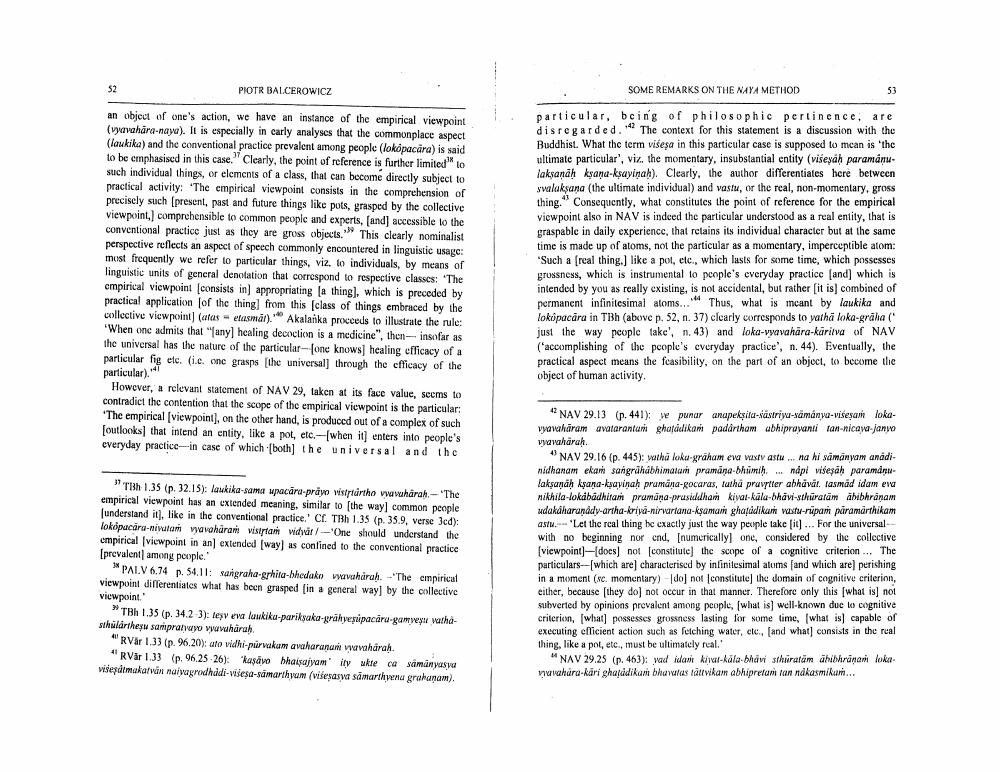Book Title: Some Remarks On The Naya Mmethod Author(s): Piotr Balcerowicz Publisher: Piotr Balcerowicz View full book textPage 9
________________ PIOTR BALCEROWICZ SOME REMARKS ON THE NAYA METHOD an object of one's action, we have an instance of the empirical viewpoint (vyavahara-nayu). It is especially in carly analyses that the commonplace aspect (laukika) and the conventional practice prevalent among people (lokopacara) is said to be emphasised in this case. Clearly, the point of reference is further limited to such individual things, or elements of a class, that can become directly subject to practical activity: 'The empirical viewpoint consists in the comprehension of precisely such (present, past and future things like pots, grasped by the collective viewpoint, comprehensible to common people and experts, and accessible to the conventional practice just as they are gross objects. This clearly nominalist perspective reflects an aspect of speech commonly encountered in linguistic usage: must frequently we refer to particular things, viz. to individuals, by means of linguistic units of general denotation that correspond to respective classes: 'The empirical viewpoint consists in appropriating a thing], which is preceded by practical application for the thing from this class of things embraced by the collective viewpoint) (utuselusmdr). Akalahka proceeds to illustrate the rule: "When one admits that any healing decoction is a medicine", then-insofar as the universal has the nature of the particular-fone knows healing efficacy of a particular fig etc. (ic. one grasps the universal] through the efficacy of the particular, being of philosophic pertinence, are disregarded. The context for this statement is a discussion with the Buddhist. What the term višesa in this particular case is supposed to mean is the ultimate particular', viz. the momentary, insubstantial entity (visesah paramánu. laksanah ksana-ksayinah). Clearly, the author differentiates here between svalaksana (the ultimale individual) and vastu, or the real, non-momentary, gross thing." Consequently, what constitutes the point of reference for the empirical viewpoint also in NAV is indeed the particular understood as a real entity, that is graspable in daily experience, that retains its individual character but at the same time is made up of atoms, not the particular as a momentary, imperceptible atom: "Such a real thing.] like a pol, etc., which lasts for some time, which possesses grussness, which is instrumental to people's everyday practice (and) which is intended by you as really existing, is not accidental, but rather it is combined of permanent infinitesimal atoms... Thus, what is meant by laukika and lokoipacara in TBh (above p. 52, n. 37) clearly corresponds to yarha loka-graha just the way people take, n. 43) and loka-vyavahara-karirva of NAV ('accomplishing of the people's everyday practice', n. 44). Eventually, the practical aspect means the feasibility, on the part of an object, to become the object of human activity, particular) 41 However, a relevant statement of NAV 29, taken at its face value, seems to contradict the contention that the scope of the empirical viewpoint is the particular: 'The empirical viewpoint), on the other hand, is produced out of a complex of such [outlooks that intend an entity, like a pot, etc.-(when it enters into people's everyday practice in case of which both the universal and the "Tih 1.35 (p. 32.15): laukika-sama upacara prayo wistyrthe wavuhärah - The empirical viewpoint has an extended meaning, similar to the way common people understand it, like in the conventional practice. Cr. Tih 1.35 (p. 35.9, verse Icd): lokopacara-nivum Warahara visita vidvat -One should understand the empirical viewpoint in an extended (way) as contined to the conventional practice [prevalent among people. PALV 6.74 p. 54.11: sangraha-grhita-bhedake wawuharah. The empirical viewpoint differentiates what has been grasped in a general way] by the collective viewpoint. Th 1.35 (p. 34.2 3): tev evalukka-parikaka-grayspacara-garve vathastilartheu samprahyo vyuvaharah RVär 1.33 (p. %6.20): ato vidhi-purvukame avaharanare avaharah "RVär 1.33 (p. 96.25-26): "kaş ve bhaisajyamity wkte casaminyusya videdimakalván n agrodhidi-vijes-samarthy (visessa samarthena graham). "NAV 29.13 (.441); w punar anapekyllu-santri-samanya-wisean lokavyavaharam avatarantani gharadikan padarthom ubhipropanti tan-nicawalan vyavaharah. NAV 29.16 (p. 445): with loku graham eva walvastu...na hi sámányan anádinidhanam ekari sangrahabhimala pramana Whimin ...ndpl visesah paramdn laksanah kşana-kavinah prumana-gocaras, luchá praviler abha var. tasmad idam eva nikhila-lokabadhitam prumāņa prasiddhan kivalkulu-Whawi-sthüratam abibhranam udakaharanády-artha-kriva nirvariana-kşama ghaddikan vasturüpam paramarthikam astu.--"Let the real thing he exactly just the way people take lit) ... For the universal with no beginning nor end, (numericallyl one, considered by the collective (viewpoint does not constitute) the scope of a cognitive criterion ... The particulars--(which are characterised by infinitesimal atums (and which are perishing in a moment (sc. momentary) do not constitute the domain of cognitive criterion, either, because they do not occur in that manner. Therefore only this [what is not subverted by opinions prevalent among people, what is well known due lo cognitive criterion, (what) possesses grossness lasting for some time, (what is capable of executing ellicient action such as fetching water, etc. (and what consists in the real thing, like a pol, etc., must be ultimately real. "NAV 29.25 (p. 463): vad idane kivar-kala-bhavi staratam ahilhranan lokaunahara-kari ghaadikan bhavulas tátvikam abhipretan tan nakasmikum...Page Navigation
1 ... 7 8 9 10 11 12 13 14 15 16 17
